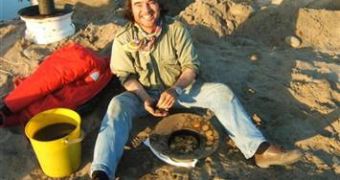This time, the treasure emerged off the coast of Namibia. The 500-year old ship was filled with tons of copper ingots, elephant tusks, gold coins, coffin-sized timber fragments, plus the cannons. The discovery was made by Namdeb Diamond Corp., a joint venture of the government of Namibia and De Beers. The geologists were looking for diamonds off Namibia.
"If you're mining on the coast, sooner or later you'll find a wreck," said archaeologist Dieter Noli of the University of Cape Town.
The finding was first reported on April 1. The company had cleared and drained a portion of seabed, building an earthen wall that kept the water out in order to start the geological investigation. The geologists first came across a few ingots, but the discovery of the cannon barrels gave them an idea of what they had just found. The earthmoving search for diamond was immediately stopped. "[This] was what I'd been waiting for for 20 years," Noli said.
The coins of the hoard were Spanish and Portuguese, and the cannon type and navigational equipment was typical for the late 1400s or early 1500s, times when the Portuguese Vasco de Gama made the first tour around Africa (and Columbus discovered the Americas). "It was a period when Africa was just being opened up, when the whole world was being opened up." said Noli.
The researches even plan to go to Portugal or Spain to find records of a vessel with similar cargo that went missing. "You don't turn a skipper loose with a cargo of that value and have no record of it. The large amount of copper could mean the ship had been sent by a government looking for material to build cannons. Trade in ivory was usually controlled by royal families, another indication the ship was on official business," Noli added.
The large number of coins also poses a mystery, as ships should have rather transported trade goods, like ivory and copper. "Either he did a very, very good deal. Or he was a pirate," Noli offered as means of explanation.
As of now, the cause of the wreck is not known but that stretch of coast is famous for fierce storms and disorienting fogs, and even modern ships, endowed with sophisticated navigational tools, often choose to avoid it. Meanwhile, the only tools discovered on the wreck were astrolabes, which can only tell how far north or south one is. "Sending a ship toward Africa in that period, that was venture capital in the extreme. These chaps were very much on the edge as far as navigation," said Noli.
The timber on the ship had been attacked by worms and lead sheets had been used to patch holes, pointing that the ship was old. "Imagine a leaky, overladen ship caught in a storm. The copper ingots, shaped like sections of a sphere, would have sat snug. But the tusks [some 50 have been found] could have shifted, tipping the ship. And down you go, weighed down by your treasure," Noli concluded by saying.

 14 DAY TRIAL //
14 DAY TRIAL //